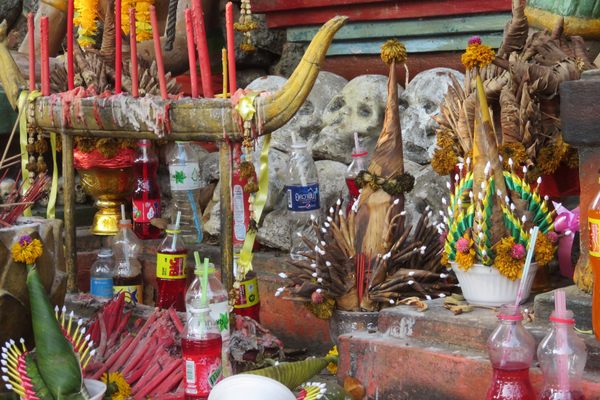Morbid Monday: The Buddhist Hell Gardens of Thailand
Photograph of mural on a Buddhist temple in northern Thailand (via Wikimedia)
In Thailand, the tradition of outdoor sculptures is almost as old as Buddhism itself. Created by monks or devoted artisans, they usually depict Buddhist cosmology and are conceived out of metal or concrete so they can last for eternity. Often surrounding Buddhist temples or monasteries, the adorned gardens serve as a prologue for one’s visit to the shrine, a delightful stroll in an elaborate environment, as well as a meditative experience.
Well, not all of them, and especially our two Morbid Monday specials! The sculpture gardens we’re traveling to today are way spookier than average. Peculiar variations of this Buddhist outdoor tradition, these incredible places are iconic representations of the handful of “Hell Gardens” spread throughout Thailand. Visually dense and graphic, they are everything but an appeasing internal journey.
Our first stop is around an hour and a half southeast from Bangkok, in the province of Chon Buri. In Wang Saen Suk, the “Wat” (the Thai name for temple) is surrounded by a landscape of gruesome scenery. Past the “Welcome to Hell” entrance sign, you’re confronted with life-size torture tableaus in this open air Pandemonium. Jaw-dropping, the grotesque depictions of the Buddhist Hell turn Bosch’s visions of the underworld into a garden party.
Hell in Wang Saen Suk (via Darmon Richter)
Like Christianity, Buddhism also has an infernal destination you could visit if you’ve not been virtuous enough, although slightly different. Called Naraka, it is composed like an underground maze with various realms and antechambers, each more violently excessive than the other. But contrary to Christian eternal damnation and because of the belief in reincarnation, the Buddhist netherworld is transitional passage, a sort of purgatory where guilty souls pay their dues and prepare for a new life transfer.
In Wang Saen Suk (via Darmon Richter)
In the Hell Gardens, anthropomorphic demons everywhere, stirring giant bowls of human soup, pulling a person’s tongue out or another’s eyes, squashing the bodies of grimacing penitents. The campy Wang Saen Suk panorama built in 1986 is a fascinating theater of cruelty. But one should not forget than the visual atrocities of Wang Saen Suk hold a very moral purpose. Hell is not a fun place to be, even for a limited time, and every drop of blood serves as a vivid reminder.
Climbing a tree of spikes (via Darmon Richter)
Cooking humans (photograph by Christopher Robin-Donham/Flickr user)
Our second infernal location, situated on the northernmost region of the country, is Wat Rong Khun, also called “The White Temple,” and is one of Thailand’s most famous contemporary landmarks.
Wat Rong Khun (photograph by Daniel Nahabedian)
In 1996, artist Chalermchai Kositpipat designed the sumptuous shrine exploring Thai art in its intricate forms through the lens of modernity. If the Wat seems to be built with the forms of traditional architecture, some of the sculptural elements, borrowed from the occidental pop culture repertoire, seem pretty uncanny.
The Pit of Hell (photograph by Daniel Nahabedian)
To access the shrine, visitors cross a little bridge passing over a “Pit of Hell” where more than a hundred tensed, anonymous arms try to pull themselves out to our reality and avoid their karmic fate. Surrounding the Temple are severed heads hanging from trees, their eyes licking the floor, while elaborate skull designs recall heavy metal album covers more than your average classic temple.
(photograph by Daniel Nahabedian)
If at the entrance, two colossal Thai demons pointing an accusing finger at you are disturbing, the presence of the alien from the film Predator, half-buried in the grass, is even stranger.
Predator of the White Temple (via Man on the Lamb)
“No smoking allowed” at the White Temple (via Wikimedia)
A small detail of a peculiar mural (via Man on the Lamb)
Inside the radiant ice castle, a demonic mural, still in progress, shows characters of blockbuster films alongside iconic objects of the occidental modern world: Neo, Avatar, Coca-Cola bottles, and futuristic spaceships replace the old demonic legions of the traditional Buddhist Hell.
While these two places of torment have been well-documented by contemporary explorers, one guesses there are probably others hidden somewhere in the country. If you stumble upon one yourself during your own journey, please, share your infernal pictures with the Obscura Team!
BUDDHIST HELL GARDENS:
WAT RONG KHUN, Ngao, Thailand
WANG SAEN SUK, Bangkok, Thailand
Morbid Mondays highlight macabre stories from around the world and through time, indulging in our morbid curiosity for stories from history’s darkest corners. Read more Morbid Mondays>
Join us on Twitter and follow our #morbidmonday hashtag, for new odd and macabre themes: Atlas Obscura on Twitter









Follow us on Twitter to get the latest on the world's hidden wonders.
Like us on Facebook to get the latest on the world's hidden wonders.
Follow us on Twitter Like us on Facebook